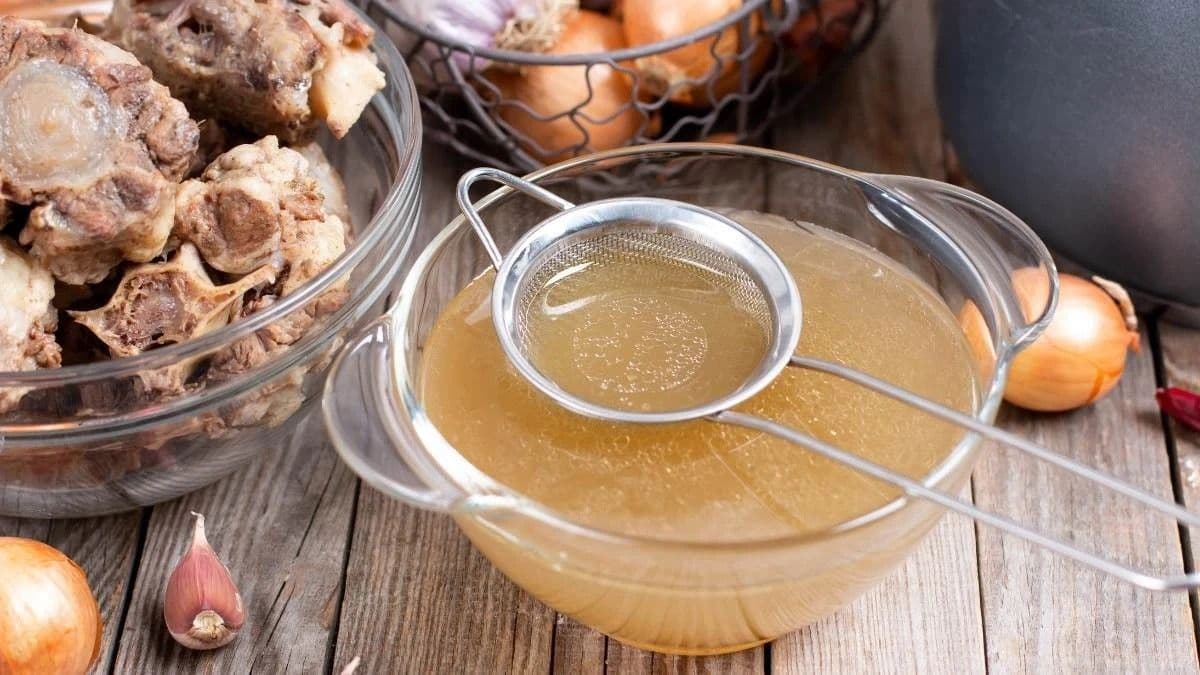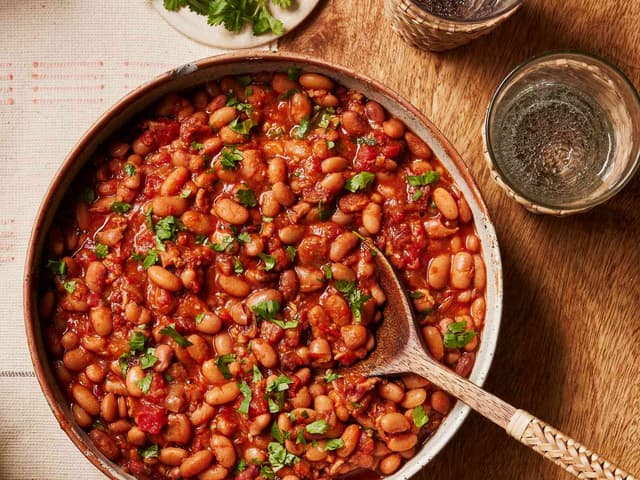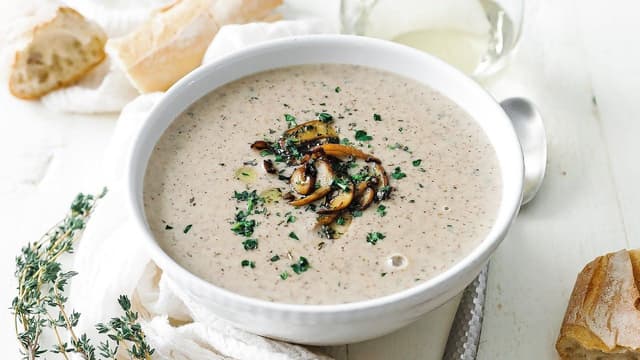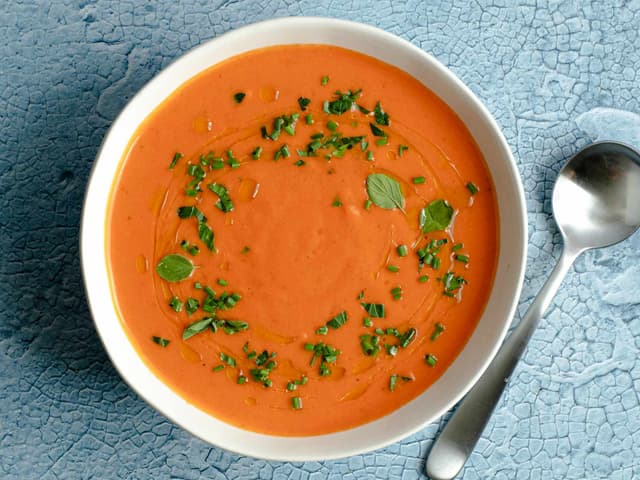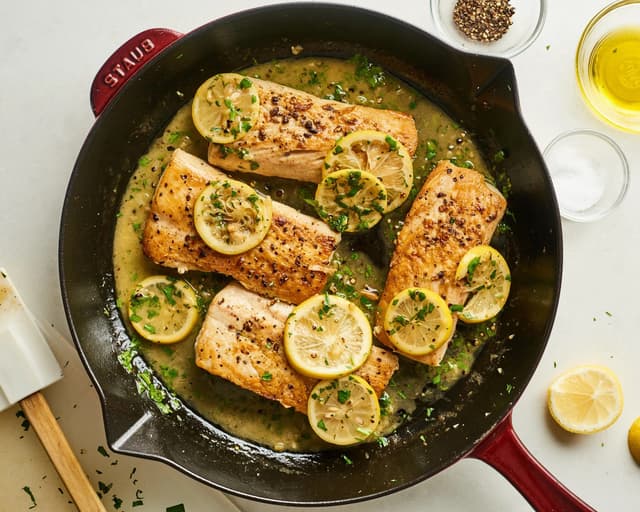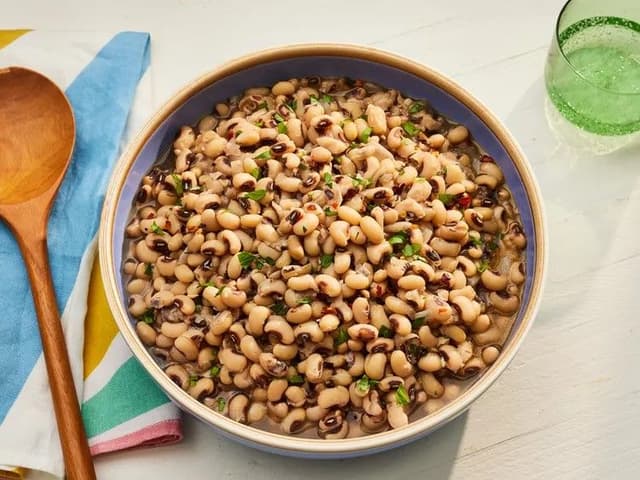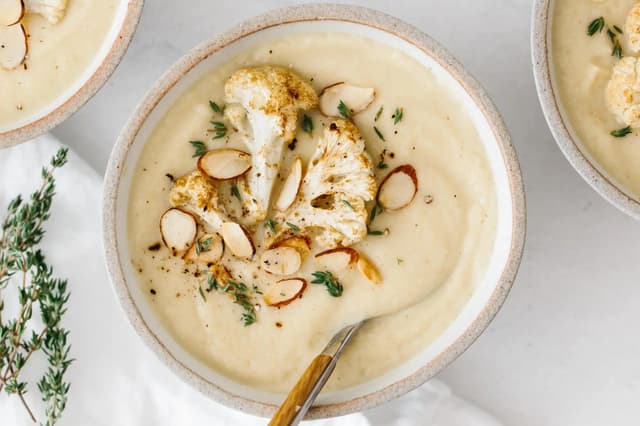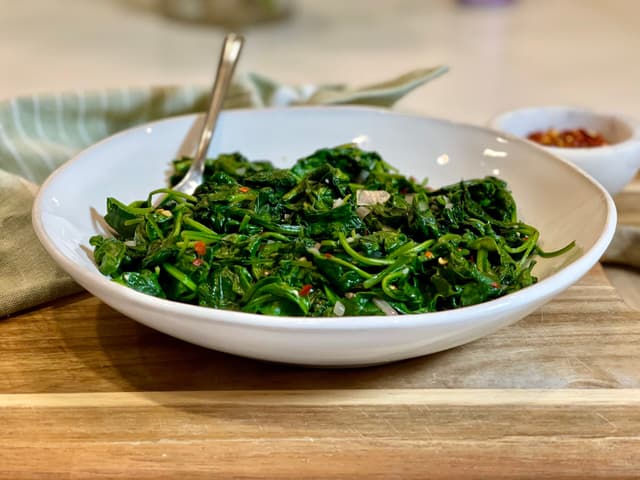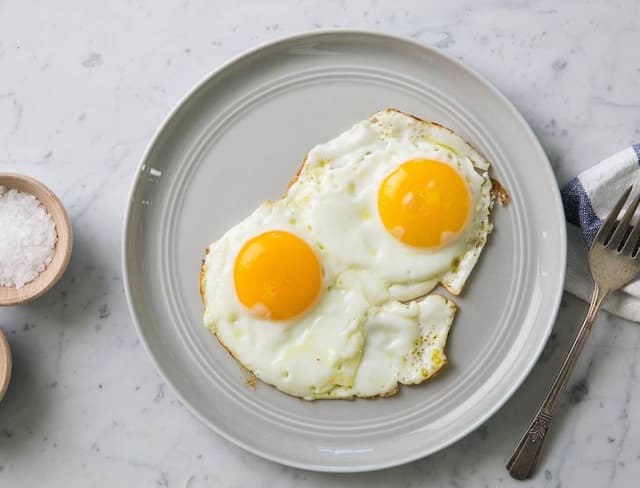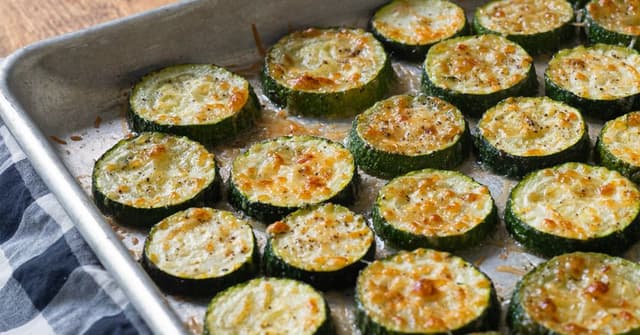Introduction
Bone broth is far more than a modern wellness trend or a fleeting "superfood". It is a timeless, comforting elixir, a deeply nourishing liquid with a history stretching back to our earliest ancestors. This simple, slow-simmered food has been a cornerstone of cuisines and traditional medicine across the globe for millennia, from hunter-gatherer "stone soups" to restorative remedies in ancient China and Greece, cherished for its ability to warm, heal, and sustain.
This ancient tradition holds a powerful place in the modern kitchen. It serves as the flavorful soul of countless global dishes, from Vietnamese pho to Italian brodo, and aligns perfectly with contemporary wellness goals, supporting everything from gut health to joint strength. This guide will demystify the art of making bone broth, transforming it from an intimidating culinary project into a simple, rewarding ritual that will enrich both your health and your cooking.
Why Make This Delicious Broth & When to Enjoy It
Crafting bone broth at home is an act of reclaiming flavor and nutrition. Unlike many store-bought stocks that can be laden with excessive sodium, preservatives, or flavor enhancers like MSG, making your own puts you in complete control. You choose the quality of the ingredients, from organic, grass-fed bones to fresh vegetables, ensuring the final product is pure and potent.
For the home cook, mastering bone broth is a gateway to deeper culinary skill. It’s a lesson in sustainability, transforming humble bones and vegetable scraps into liquid gold, ensuring no part of the animal goes to waste. Its versatility is unmatched; it can elevate a simple pot of rice, form the base of a complex stew, or enrich a pan sauce, adding a depth of flavor that water or commercial broths simply cannot replicate.
The true beauty of bone broth lies in its adaptability to your life and needs. You can design your own ritual around it, timing your consumption to achieve specific wellness goals.
- For Comfort and Warmth: There is nothing quite like a steaming mug of broth on a chilly day or when you're feeling under the weather. Its reputation as "Jewish penicillin" is well-earned, offering solace and nourishment when you need it most.
- For Wellness Routines:
- Morning Boost: Start your day with a warm cup instead of coffee. It provides gentle, sustained energy without the jitters and helps prepare your digestive system for the day ahead.
- Workout Fuel & Recovery: Sip it before or after exercise. The protein and amino acids help fuel and repair muscles, while natural electrolytes support hydration.
- Afternoon Pick-Me-Up: When the 3 p.m. slump hits, a savory cup of bone broth can satisfy hunger and stabilize energy levels far better than a sugary snack.
- Evening Wind-Down: Enjoy a mug an hour before bed. The naturally occurring amino acid glycine has been shown to promote relaxation and more restful sleep.
- As a Culinary Base: It is the foundational secret ingredient in kitchens worldwide. Use it to build unforgettable soups, stews, risottos, and sauces that resonate with rich, authentic flavor.

Basic Ingredients (Makes approx. 12-14 cups)
- 3-4 pounds Beef Bones: Use a mix of marrow, knuckle, and oxtail bones. This variety is the secret to a well-rounded broth; marrow bones lend richness and minerals, while collagen-packed knuckle and oxtail bones break down into the gelatin that creates a perfect, jiggly set.
- 2 tablespoons Apple Cider Vinegar: This acid is your key extractor. It works as a catalyst, helping to break down the tough connective tissues and draw valuable minerals like calcium and magnesium out of the bones and into your broth, maximizing its nutritional potential.
- 2 large Carrots, coarsely chopped: As a core component of the classic mirepoix flavor base, carrots provide a subtle, earthy sweetness that beautifully balances the deep, savory flavor of the beef, all while contributing their own vitamins and minerals to the final product.
- 2 stalks Celery, coarsely chopped: The second pillar of the mirepoix, celery adds a fresh, slightly peppery, and savory note. This aromatic complexity brightens the broth's overall flavor profile and prevents it from tasting heavy or one-dimensional.
- 1 large Onion, quartered, skin on: The onion provides the pungent, sweet foundation essential to any good stock. Leaving the papery outer skin on is a classic chef's trick that imparts a gorgeous, deep golden-brown color to the finished broth, making it as visually appealing as it is flavorful.
- 1 whole head Garlic, halved crosswise: Garlic adds a robust, savory, and aromatic depth that harmonizes with the beef and vegetables. Its potent flavor is fundamental to a rich-tasting broth, and it brings its own reputed anti-inflammatory properties to the pot.
- 1 teaspoon whole Black Peppercorns: Using whole peppercorns is a deliberate choice for a superior broth. They release their gentle, lingering warmth slowly during the long simmer, providing spice without the cloudiness or harshness that ground pepper can introduce.
- 2 Bay Leaves: These humble dried leaves are the unsung heroes of the stockpot. They contribute a subtle, savory, and almost floral background note that ties all the other aromatic flavors together into a complex and harmonious whole.
- 12-16 cups Cold, Filtered Water: Starting with cold water is non-negotiable for a clear broth. It allows unwanted proteins to coagulate slowly and rise to the top, where they can be easily skimmed off. Using just enough water to cover the ingredients ensures a concentrated, not diluted, result.

Step-by-Step Preparation
Making bone broth is less about complex cooking and more about mastering a series of controlled processes. Each step is designed to either create a desirable chemical reaction, like browning for flavor, or prevent an undesirable one, like boiling that creates a cloudy liquid. By understanding the "why," you're not just following a recipe—you're mastering a timeless technique.
- Roast the Bones for Flavor: Preheat your oven to 425°F (220°C). Spread the 3-4 pounds of beef bones in a single layer on a large, rimmed baking sheet and roast for 30-45 minutes, turning them once halfway through. This is the most important step for developing a deep, rich, caramelized flavor through the Maillard reaction, which gives the broth its signature savory taste and beautiful brown color.
- Deglaze the Pan: Once the bones are deeply browned, use tongs to carefully transfer them to a large stockpot. Place the hot roasting pan across two burners on your stovetop over low heat. Pour in a cup of water and use a sturdy spatula to scrape up all the dark, flavorful bits stuck to the bottom of the pan—this is the "fond." Pour this intensely concentrated flavor essence directly into the stockpot.
- Combine Ingredients and Add Acid: To the pot with the bones, add the chopped 2 carrots, 2 stalks of celery, 1 quartered onion, and the halved head of garlic. Pour in the 12-16 cups of cold water, ensuring the ingredients are covered by about two inches. Finally, stir in the 2 tablespoons of apple cider vinegar. Let the pot rest for 30-60 minutes before applying heat to give the vinegar a head start on mineral extraction.
- Bring to a Simmer and Skim: Place the pot over high heat and bring the water slowly to a boil. As it heats up, a layer of grayish foam, or "scum," will form and rise to the surface; these are simply coagulated proteins. Using a large spoon or a fine-mesh skimmer, diligently skim off this foam and discard it. This must be done before the broth reaches a hard boil, as it is crucial for achieving a clear, clean-tasting final product.
- Simmer Low and Slow: Once the initial scum is removed, immediately reduce the heat to the lowest possible setting to maintain a very gentle simmer—you should only see a few bubbles lazily breaking the surface every few seconds. Add the 1 teaspoon of black peppercorns and 2 bay leaves. Partially cover the pot, leaving a small gap for steam to escape, and let it simmer for at least 12 hours, and up to 24 hours for large beef bones. Do not stir the broth, as agitation can make it cloudy.
- Strain the Broth: Turn off the heat and allow the broth to cool slightly for easier handling. Use tongs to remove the large bones and vegetable chunks. Place a large fine-mesh strainer over another clean pot or heatproof bowl—for an exceptionally clear broth, line the strainer with a layer of cheesecloth. Carefully pour the broth through the strainer to separate the golden liquid from all remaining solids.
- Cool and Defat: To ensure food safety, cool the strained broth as quickly as possible by placing the pot in an ice bath in your sink and stirring occasionally. Once cooled, transfer the broth into jars or containers and refrigerate overnight. The next day, a solid cap of fat will have formed on the surface. This can be easily lifted off with a spoon, leaving you with pure, concentrated broth ready for use.

Tips for the Perfect Broth
Think of yourself as a broth artisan, tuning a set of dials to create a final product that is perfect for you. The three primary qualities of a great broth—a rich gel, crystal clarity, and deep flavor—are interconnected. By understanding how to adjust the process, you can emphasize the qualities you value most.
- For a Rich, Gelatinous Broth:
- Use the Right Bones: This is the most important dial to turn for a good gel. Prioritize collagen-heavy parts like beef knuckles, chicken feet, and oxtails. A mix of different types of bones will yield the most reliable results.
- Correct Water Ratio: Be careful not to drown your bones. Add just enough cold water to cover them by an inch or two. Using too much water is the most common reason for a broth that doesn't gel, as it dilutes the collagen.
- Simmer, Don't Boil: A hard, rolling boil is the enemy of gelatin. It can break down the delicate protein strands, preventing them from forming a gel when cooled. Maintain a very gentle simmer, ideally between 180-200°F (82-93°C).
- Don't Overcook: While a long simmer is good, there is a point of diminishing returns. Excessively long cooking can also cause collagen to break down. Stick to the recommended times: 12-24 hours for beef and 8-12 for chicken is usually optimal.
- For a Clear, Golden Broth:
- Blanch First (Optional): For a consommé-like clarity, you can turn up the "purity" dial by blanching the bones first. Cover them with cold water, boil for 20 minutes, then drain and rinse the bones thoroughly before roasting. This removes a significant amount of impurities from the start.
- Skim Diligently: Be vigilant during the first hour of simmering. Removing all the scum that rises to the surface is the single most effective step for achieving a clear broth.
- Start Cold: Always begin with cold water. This allows impurities to coagulate slowly and float to the top, making them much easier to skim off before they can cloud the liquid.
- Strain Carefully: Use a fine-mesh sieve for straining. For ultimate clarity, line the sieve with a few layers of cheesecloth to catch even the most microscopic particles.
- For Maximum Flavor:
- Always Roast Your Bones: For a deep, savory, and complex beef broth, this step is non-negotiable. The browning and caramelization that occurs in the oven is where foundational flavor is built.
- Use Aromatic Vegetables: A classic mirepoix of onion, carrot, and celery is the soul of a flavorful broth. For the best taste, add them during the last few hours of cooking. Adding them too early can cause them to break down and impart a bitter taste.
- Save the Fat: The fat cap you remove from the chilled broth is culinary gold. Gently reheat it in a pan to cook off any remaining water, strain it, and store it in a jar in the fridge. This rendered beef fat, or tallow, is incredible for roasting potatoes or frying eggs.

Serving Ideas
Once you have your liquid gold, the possibilities are nearly endless. You can enjoy it in its purest form or use it as a secret weapon to elevate your everyday cooking.
- Simple & Soothing Sips:
- The Purist: There's nothing more classic than a warm mug of broth seasoned with nothing more than a pinch of high-quality sea salt to let its natural flavor shine.
- Aromatic Infusions: Brighten your cup by adding freshly grated ginger or turmeric, a squeeze of fresh lime juice, and a handful of chopped fresh herbs like parsley, cilantro, or chives.
- Spicy Kick: For a warming, sinus-clearing drink, add a dash of your favorite hot sauce, a few slices of fresh jalapeño, or a sprinkle of red pepper flakes.
- As a Culinary Powerhouse:
- The Ultimate Soup Base: Your homemade broth is the perfect foundation for world-class soups like French Onion, Vietnamese Pho, or a deeply comforting chicken noodle soup.
- Upgrade Your Grains: Transform everyday grains by cooking them in bone broth instead of water. Rice, quinoa, and farro will absorb the rich flavor and gain a boost of protein.
- Rich and Flavorful Sauces: Use it to create luxurious pan sauces after searing meat, as the base for a traditional gravy, or as the liquid in a hearty Bolognese or Shepherd's Pie.
- Better Braises and Stews: It's the ideal liquid for slow-braising tough cuts of meat until they are fall-apart tender and for building stews with incredible depth and complexity.
- Creative & Unexpected Uses:
- Savory Smoothies: Add a few frozen bone broth cubes to your morning smoothie. You'll get a hidden boost of protein and collagen, and the flavor is easily masked by fruit and greens.
- Nourishing "Brothsicles": For a healthy summer treat, blend bone broth with your favorite fruits and freeze the mixture in popsicle molds. It's a fantastic way to get gut-friendly nutrients into kids.
- Dips and Spreads: Replace the water or oil in recipes for hummus, bean dips, or cashew cheese with a tablespoon or two of bone broth to add a unique savory depth.
- The Bloody Bull Cocktail: A savory and sophisticated twist on the classic Bloody Mary, this cocktail uses beef broth for a rich, umami-packed experience.

Tips for Storing and Keeping Fresh
Proper storage is key to preserving the quality and safety of your homemade bone broth. Follow these best practices to keep your liquid gold fresh and ready to use.
- Storing Bone Broth
- Refrigeration: Once cooled, you can store your broth in airtight containers, such as glass mason jars, in the refrigerator for up to 5-7 days. The hardened fat cap will create a natural seal, but it's best to use it within this timeframe for optimal freshness.
- Freezing for Long-Term: Freezing is the best method for long-term storage, keeping your broth fresh for up to 6 months.
- Freezer-Safe Jars: If using glass jars for freezing, be sure to choose straight-sided "freezer-safe" models. Crucially, you must leave at least one inch of empty space (headspace) at the top to allow the liquid to expand as it freezes, which prevents the glass from cracking.
- Silicone Molds/Ice Cube Trays: For maximum convenience, pour cooled broth into silicone molds or standard ice cube trays. Once the cubes are frozen solid, transfer them to a labeled freezer bag. This allows you to easily grab small, pre-portioned amounts for sauces or single servings.
- Keeping It Fresh
- Cool Quickly: The most critical step for food safety is to cool the broth rapidly after straining. Placing the pot of strained broth in an ice bath in your sink is the most effective way to lower its temperature quickly and minimize the time it spends in the "danger zone" where bacteria can grow.
- Don't Put Hot Broth in the Fridge: Never place a large, hot pot of broth directly into your refrigerator. It can raise the internal temperature of the entire appliance to unsafe levels for your other food and will not cool the broth down quickly enough to prevent bacterial growth.
- The Fat Cap Seal: When you refrigerate your broth, the solidified fat on top creates an effective airtight barrier. As long as this seal remains solid and unbroken, it protects the broth underneath from exposure to air and contaminants.
- Re-Boiling to Extend Life: If you're approaching the end of the 5-7 day window for refrigerated broth, you can extend its life by a few more days. Simply bring the broth to a rolling boil for a couple of minutes, then cool it quickly and return it to the fridge.

Conclusion
Embracing the art of making bone broth connects you to a rich culinary heritage, transforming a simple act of cooking into a deeply rewarding practice. It is a journey from humble ingredients to a nourishing, flavorful elixir that can warm your soul, elevate your cooking, and support your well-being. We encourage you to start your own tradition, fill your home with its comforting aroma, and discover the simple magic of liquid gold.
Frequently Asked Questions
Q: What's the real difference between bone broth and stock?
A: While the terms are often used interchangeably, the main differences are simmer time and intent. Bone broth is essentially stock simmered for much longer (12+ hours vs. 4-6 for stock) to extract maximum collagen, resulting in a gelatinous liquid often sipped on its own.
Q: My bone broth didn't turn into jelly. What did I do wrong?
A: This is a common issue, usually caused by too much water for the amount of bones, not using enough collagen-rich parts like joints and feet, or boiling it too hard instead of gently simmering. A watery broth is still delicious and nutritious, so don't discard it!
Q: Is it possible to overcook bone broth?
A: Yes, it is. While a long simmer is key, excessive cooking can cause vegetables to break down and impart a bitter taste, or the bones themselves can lend an off-flavor. For the best result, stick to the recommended 12-24 hour window for beef or 8-12 for chicken.
Q: Do I really need to add vinegar?
A: Adding an acid like apple cider vinegar is a traditional step thought to help pull more minerals from the bones, and we recommend it for a potential nutritional boost. However, your broth will still be wonderfully flavorful and gelatinous without it if you prefer to leave it out.
Works cited
- The Rich History of Bone Broth: From Ancient Times to Modern Wellness, accessed July 10, 2025, https://www.britishbrothcompany.com/the-rich-history-of-bone-broth-from-ancient-times-to-modern-wellness/
- Bone broth: Why the 'original superfood' is trending and how to stock it | Food & Drink, accessed July 10, 2025, https://www.specialityfoodmagazine.com/food-and-drink/bone-broth-why-the-original-superfood-is-trending-and-how-to-stock-it
- The Rich History of Bone Broth, accessed July 10, 2025, https://www.australianbonebrothco.com.au/blogs/from-the-blog/the-rich-history-of-bone-broth
- What is Bone Broth? | History & Origins - Nutra Organics, accessed July 10, 2025, https://nutraorganics.com/blogs/blog/what-is-bone-broth
- The Surprising History Behind Bone Broth - The Kettle & Fire Blog, accessed July 10, 2025, https://blog.kettleandfire.com/the-surprising-history-behind-bone-broth/
- Bone Broth Around the World - Freja, accessed July 10, 2025, https://frejafoods.com/blogs/journal/bone-broth-around-the-world
- History of Bone Broth: Ancient Origins & Evolution - Ossa Organic, accessed July 10, 2025, https://www.ossaorganic.com/blogs/blog/the-history-of-bone-broth
- Is Bone Broth Healthy? - Canadian Digestive Health Foundation, accessed July 10, 2025, https://cdhf.ca/en/is-bone-broth-healthy/
- 5 Things to Know About the Bone Broth Trend - MICHELIN Guide, accessed July 10, 2025, https://guide.michelin.com/us/en/article/wellness/bone-broth-trend
- Simple Bone Broth - Recipe - Natural Nourishment, accessed July 10, 2025, https://www.naturalnourishment.me/recipes/recipe-simple-bone-broth
- How to Drink Bone Broth: Ways to Warm Up Your Day - Pacific Foods, accessed July 10, 2025, https://www.pacificfoods.com/blog/how-to-drink-bone-broth/
- The Health Benefits of Bone Broth - AANMC, accessed July 10, 2025, https://aanmc.org/naturopathic-kitchen/bone-broth/
- Our Favorite Ways to Use Bone Broth - Pacific Foods, accessed July 10, 2025, https://www.pacificfoods.com/blog/how-to-use-bone-broth/
- 5 of The Best Times to Sip Bone Broth, accessed July 10, 2025, https://denverbonebroth.com/blogs/news/the-best-times-to-sip-bone-broth
- The Best Time to Drink Bone Broth for a Healthy Gut, Better Sleep, and More, accessed July 10, 2025, https://www.verywellhealth.com/best-time-to-drink-bone-broth-11733926
- The Morning Ritual of Drinking Bone Broth - Nutra Organics, accessed July 10, 2025, https://nutraorganics.com.au/blogs/blog/the-morning-ritual-of-drinking-bone-broth
- When is the Best Time To Drink Bone Broth [New Data] - Bluebird Provisions, accessed July 10, 2025, https://bluebirdprovisions.co/blogs/news/best-time-drink-bone-broth
- When to Drink Bone Broth: Best Times and Benefits - Freja, accessed July 10, 2025, https://frejafoods.com/blogs/journal/when-to-drink-bone-broth
- Bone Broth: Benefits, How To Make and Nutrition, accessed July 10, 2025, https://health.clevelandclinic.org/bone-broth-benefits
- www.ossaorganic.com, accessed July 10, 2025, https://www.ossaorganic.com/blogs/blog/the-history-of-bone-broth#:~:text=Early%20Bone%20Broth%20History&text=More%20than%202%2C500%20years%20ago,Chinese%2C%20Korean%20and%20Japanese%20soups.
- Beef Bone Broth Recipe - Allrecipes, accessed July 10, 2025, https://www.allrecipes.com/recipe/276115/beef-bone-broth/
- How to Make Bone Broth in 6 Steps - 2025 - MasterClass, accessed July 10, 2025, https://www.masterclass.com/articles/how-to-make-bone-broth
- How to: Bone Broth + Common Mistakes [Instant Pot & Stovetop Method] — The North + West Kitchen, accessed July 10, 2025, https://www.thenorthwestkitchen.com/blog/bone-broth-how-to
- Homemade Beef Bone Broth - Fed & Fit, accessed July 10, 2025, https://fedandfit.com/beef-bone-broth/
- Here's What To Do If Your Bone Broth Doesn't Gel - Daily Meal, accessed July 10, 2025, https://www.thedailymeal.com/1095139/heres-what-to-do-if-your-bone-broth-doesnt-gel/
- This Is the Best Bone Broth Recipe for Flavor and Nutrition - Hers, accessed July 10, 2025, https://www.forhers.com/blog/bone-broth-recipe
- Soup Secret: The Surprising Benefits of Adding Apple Cider Vinegar to Bone Broth - toronto soup co., accessed July 10, 2025, https://www.torontosoupco.com/blog/soup-secret-the-surprising-benefits-of-adding-apple-cider-vinegar-to-bone-broth
- Must-Have Ingredients for a Perfect Bone Broth | The Nauvoo, accessed July 10, 2025, https://thenauvoo.com/must-have-ingredients-for-a-perfect-bone-broth/
- Bone Broth - Edible Bozeman, accessed July 10, 2025, https://www.ediblebozeman.com/recipe/bone-broth/
- What are your go to Bone Broth recipes? : r/ketorecipes - Reddit, accessed July 10, 2025, https://www.reddit.com/r/ketorecipes/comments/18uvi68/what_are_your_go_to_bone_broth_recipes/
- What can I simmer with beef broth to make a simple clear soup? - Quora, accessed July 10, 2025, https://www.quora.com/What-can-I-simmer-with-beef-broth-to-make-a-simple-clear-soup
- How to Make Beef Stock - Simply Recipes, accessed July 10, 2025, https://www.simplyrecipes.com/recipes/how_to_make_beef_stock/
- Making Bone Broth - Traditional Stock - River Cottage Farm, accessed July 10, 2025, https://rivercottagefarm.net/making-bone-broth-traditional-stock/
- Bone Broth Recipe (How to Make Perfect Beef Bone Broth) | The Kitchn, accessed July 10, 2025, https://www.thekitchn.com/how-to-make-bone-broth-cooking-lessons-from-the-kitchn-215311
- Do you really need to skim off scum on the surface of bone broth? - Umami Days, accessed July 10, 2025, https://umamidays.com/do-you-really-need-to-skim-off-scum-on-the-surface-of-bone-broth/
- How To Skim Off the Scum and Fat from Soups and Stocks (灰汁取り) - Just One Cookbook, accessed July 10, 2025, https://www.justonecookbook.com/how-to-skim-off-the-scum-and-fat-from-soups-and-stocks/
- Bone Broth, accessed July 10, 2025, https://boroughbroth.co.uk/blogs/recipes/bone-broth
- 3 Ways to Make Bone Broth (Stovetop, Slow Cooker, Instant Pot) - Buy Ranch Direct, accessed July 10, 2025, https://buyranchdirect.com/blogs/recipes/basic-bone-broth
- How to Save the Fat from Bone Broth - What Great Grandma Ate, accessed July 10, 2025, https://whatgreatgrandmaate.com/how-to-save-the-fat-from-bone-broth/
- 5 Reasons Your Bone Broth Isn't Gelatinous - Fearless Eating, accessed July 10, 2025, https://fearlesseating.net/5-reasons-bone-broth-doesnt-gel/
- Bone Broth Simmer Temperature Range #859606 - Ask Extension, accessed July 10, 2025, https://ask.extension.org/kb/faq.php?id=859606
- michelineandrews.com.au, accessed July 10, 2025, https://michelineandrews.com.au/why-didnt-my-bone-broth-gel/#:~:text=7%20ways%20to%20get%20a%20good%20gel%20on%20your%20bone%20broth&text=You%20need%20lots%20of%20bones,and%20get%20a%20good%20gel.
- Clarifying Broth : r/Cooking - Reddit, accessed July 10, 2025, https://www.reddit.com/r/Cooking/comments/52wr1c/clarifying_broth/
- Why skim "scum" from the surface of a simmering stock? - Seasoned Advice, accessed July 10, 2025, https://cooking.stackexchange.com/questions/20390/why-skim-scum-from-the-surface-of-a-simmering-stock
- I'm looking for bone broth recipes that taste good which contain zero ingredients except for seasonings. : r/EatCheapAndHealthy - Reddit, accessed July 10, 2025, https://www.reddit.com/r/EatCheapAndHealthy/comments/x09kb1/im_looking_for_bone_broth_recipes_that_taste_good/
- Food Science Slice: 3 Mistakes You Make When Cooking Stock, accessed July 10, 2025, https://wedge.coop/article/food-science-slice-3-mistakes-make-cooking-stock/
- If you're ever skimming off fat off stock/broth, don't throw it away!!!! : r/Cooking - Reddit, accessed July 10, 2025, https://www.reddit.com/r/Cooking/comments/py0o9a/if_youre_ever_skimming_off_fat_off_stockbroth/
- 7 Bone Broth Sipping Recipes | Elana's Pantry, accessed July 10, 2025, https://elanaspantry.com/7-bone-broth-sipping-recipes/
- 12 Unique Ways to Use Bone Broth - Buy Ranch Direct, accessed July 10, 2025, https://buyranchdirect.com/blogs/recipes/12-nutritious-ways-to-use-bone-broth
- BONE BROTH 101: HOW TO SEASON, EAT & DRINK BONE BROTH. | Kale & Caramel, accessed July 10, 2025, https://kaleandcaramel.com/food/bone-broth-101-how-to-season-eat-drink-bone-broth/
- 35 Bone Broth Recipes | Nourishing & Flavorful - PaleOMG, accessed July 10, 2025, https://paleomg.com/35-bone-broth-recipes/
- 15 Delicious Ways to Use Bone Broth in Your Summer Cooking - The Kettle & Fire Blog, accessed July 10, 2025, https://blog.kettleandfire.com/bone-broth-summer-cooking/
- Bone Broth: Nutrients, Benefits, and How to Make - Healthline, accessed July 10, 2025, https://www.healthline.com/nutrition/bone-broth
- Bone Broth: A-Z - Grand View Farm, accessed July 10, 2025, https://grandviewfarming.com/blog/bone-broth-a-z
- How to Store Bone Broth, accessed July 10, 2025, https://nomnompaleo.com/post/98290360103/how-to-store-bone-broth
- How to Store Bone Broth - Nourished Kitchen, accessed July 10, 2025, https://nourishedkitchen.com/how-to-store-bone-broth/
- How to Keep Homemade Broth Preserved for up to 6 Months!, accessed July 10, 2025, https://www.myhumblekitchen.com/2014/11/keep-homemade-broth-preserved-6-months-canning-freezing-required/
- Broth vs. Stock vs. Bone Broth | Swanson® - Campbells.com, accessed July 10, 2025, https://www.campbells.com/swanson/broth-vs-stock-vs-bone-broth/
- BONE BROTH VS. STOCK VS. BROTH: WHAT'S THE DIFFERENCE? | Mother's Market, accessed July 10, 2025, https://www.mothersmarket.com/bone-broth-vs-stock-vs-broth-whats-the-difference/
- Instant Pot Bone Broth - The Real Food Dietitians, accessed July 10, 2025, https://therealfooddietitians.com/how-to-make-instant-pot-bone-broth/
- Beef bone broth question: possible to overcook in pressure cooker? : r/Cooking - Reddit, accessed July 10, 2025, https://www.reddit.com/r/Cooking/comments/m58yiz/beef_bone_broth_question_possible_to_overcook_in/
